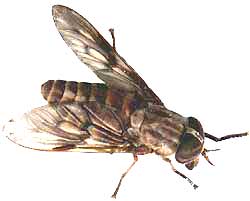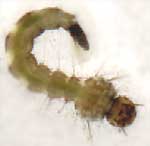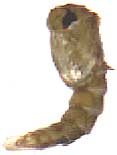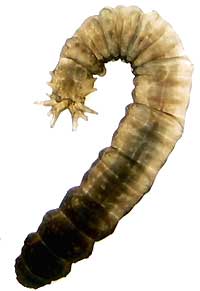 English Name: horse fly
English Name: horse flyFamily: Tabanidae (horse, deer flies)
Genus: Tabanus
Species: ?
 English Name: horse fly
English Name: horse fly
Family: Tabanidae (horse, deer flies)
Genus: Tabanus
Species: ?
After jogging at dawn I was standing outside washing myself off when the big fly at the right (nearly an inch long, or 23 mm) landed on the calf of one of my legs and quickly began cutting into my skin. By the time I felt the burning sensation, already she'd drawn blood, for blood is what she wanted, to help her eggs develop, the same as among the mosquitoes, who appear in this same order. Horse fly mouth parts are classified as sucking -- they don't really "chew" holes in our skin. Rather, beneath their sucking-tube they possess mandibles which cross one another like scissors blades with saw-like teeth along their margins. A fly then "scissors" her way into our hides, and I'm here to tell you that a good bite can be painful! By the way, I got that picture because I swatted at her, dazed her, and managed to scan her before she "got her senses back"... You can see a great shot of her mouth parts on our mouth parts page.

English Name: mosquito
Family: Culicidae (mosquitoes)
Genus: Aedes
Species: albopictus
You'd be surprised at how many species of mosquito there are! The one at the right is the Asian Tiger Mosquito distinguished by the conspicuous, metallic-like, silvery spots on its body. Actually, at first I misidentified it, but then I was corrected by Ary Farajollahi of Rutgers University in the US, so this shows that even when you try your best, sometimes you misidentify things.  The picture at the left shows a much-enlarge mosquito larva, with the head being the spherical thing in the picture's lower, right corner. Mosquito larvae are aquatic
-- they live in water.
The picture at the left shows a much-enlarge mosquito larva, with the head being the spherical thing in the picture's lower, right corner. Mosquito larvae are aquatic
-- they live in water.  See that black object at the larva's tail? That's a siphon tube the larva uses a little like a snorkel. The underwater larva needs air so it wiggles its way to the water's surface, sticks the tube up to the air, and takes air in through the tube. Larvae feed on micro-organisms and organic matter in the water. On the fourth molt the larva changes into a pupa, one of which is shown at the right. In real life the pupa shown is only 0.14 inch long (3.5 mm) so these are small. Still, mosquito pupae are of course larger than the larvae. If you think you see a mouth on that pupa, by the way, you're wrong, since mosquito pupae don't eat. They stay pupae only for a couple of days or so, and then they metamorphose into adult mosquitoes.
See that black object at the larva's tail? That's a siphon tube the larva uses a little like a snorkel. The underwater larva needs air so it wiggles its way to the water's surface, sticks the tube up to the air, and takes air in through the tube. Larvae feed on micro-organisms and organic matter in the water. On the fourth molt the larva changes into a pupa, one of which is shown at the right. In real life the pupa shown is only 0.14 inch long (3.5 mm) so these are small. Still, mosquito pupae are of course larger than the larvae. If you think you see a mouth on that pupa, by the way, you're wrong, since mosquito pupae don't eat. They stay pupae only for a couple of days or so, and then they metamorphose into adult mosquitoes.
 English Name: crane fly (larva shown at right)
English Name: crane fly (larva shown at right)
Family: Tipulidae (crane flies)
Genus: ?
Species: ?
Adult crane flies look like huge, leggy mosquitoes, but the aquatic larvae look like the interesting item at the right, discovered by two young amateur naturalists playing in their backyard stream. The budding biologists reported that these "worms" were noted to "swim with a side to side swishing of the front and back type movement, are about 1/4 inch in diameter, and can stretch and contract from 1 to 2 inches long." In North America nearly 1,500 crane fly species are known and most larvae live in water or moist soil, and typically feed on decaying plant material. One neat thing about crane flies is that, despite their similarity to mosquitoes, they don't bite.